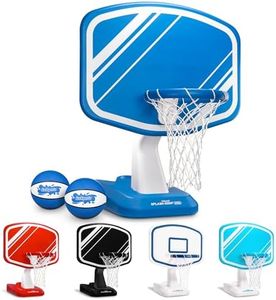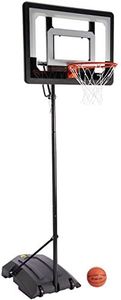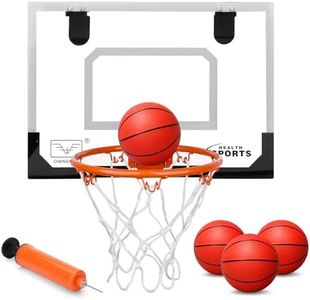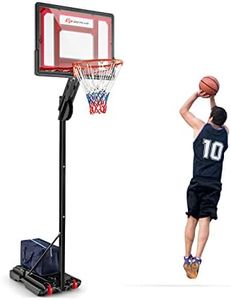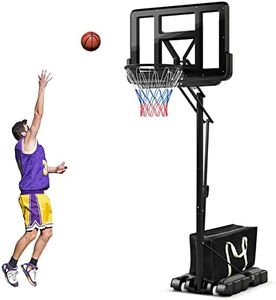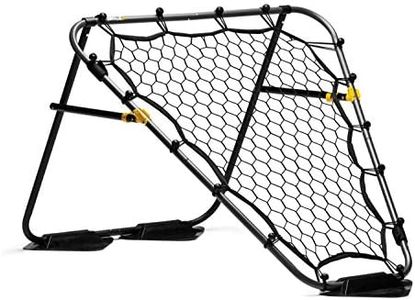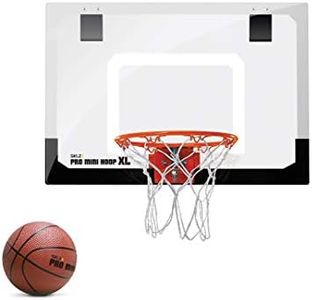We Use CookiesWe use cookies to enhance the security, performance,
functionality and for analytical and promotional activities. By continuing to browse this site you
are agreeing to our privacy policy
10 Best Basketball Hoops
From leading brands and best sellers available on the web.Buying Guide for the Best Basketball Hoops
Picking the right basketball hoop is an exciting process that comes down to how and where you want to play. The best hoop for you depends on your playing style, available space, who will be using it, and how portable or permanent you want it to be. Taking a closer look at the key features will help you make a choice that you’ll be happy with for years, whether you’re shooting solo, playing with kids, or hosting neighborhood games.Backboard MaterialThe backboard is the flat surface behind the hoop that rebounds the ball. Its material affects how the ball bounces and how professional the experience feels. Generally, you’ll see polycarbonate (plastic), acrylic, and tempered glass. Polycarbonate is most durable for casual family use and kids, but has a less responsive bounce. Acrylic offers a balanced performance with better rebound, suitable for players looking for a step up. Tempered glass is closest to what the pros use, giving great ball response, but it’s heavier and best for serious play. Choose based on who will use it and how authentic of a basketball feel you want—kids’ play is fine with polycarbonate, while teens and adults will enjoy acrylic or glass.
Backboard SizeBackboard size impacts your shooting experience and the types of shots you can practice. Backboards typically range from about 44 inches to 72 inches across. Smaller sizes (44–54 inches) are compact and work well for tight spaces or young players, but they make bank shots a bit harder. Mid-range sizes (54–60 inches) are a good compromise for families or regular players. Full-size backboards (72 inches) match professional standards, offering the best play for serious players or larger driveways. The size you pick should match your space and skill level.
AdjustabilityAdjustability refers to how easily you can change the height of the hoop. This matters if players of different ages will use the hoop, or if you want to practice different types of shots. Some hoops let you quickly adjust from about 7.5 to 10 feet. Fixed-height hoops are simpler but less flexible. If you have growing children or anticipate a mix of players, choose an adjustable hoop so everyone can play at their comfort level.
Pole Type and StabilityThe pole supports the hoop and affects its stability. There are round and square poles, and the number of pieces (one-piece, two-piece, three-piece) changes how sturdy the hoop feels. One-piece poles are very stable and suitable for aggressive play, typical for permanent installations. Two-piece and three-piece poles are often used in portable models and offer easier setup, but can shake more during play. Consider a more stable pole if you’re playing competitively, but a simpler design suffices for recreational use.
Mounting Type: Portable vs. In-ground vs. Wall-mountedThis spec tells you how and where the hoop will stand. Portable hoops rest on a weighted base and are easy to move—good for driveways or renters. In-ground hoops are cemented in place, offering the most stability for regular, competitive play, but you need to install them permanently. Wall-mounted hoops attach directly to a building and are great for saving space if you have a sturdy wall. Choose the type that fits your space and whether you want the option to move your hoop.
Rim TypeThe rim, or the actual hoop, can be standard or breakaway. Breakaway rims include springs that let the rim flex when players dunk, making them safer and more durable for aggressive play. Standard rims don’t offer this flex and are better for casual or beginner use. If dunking or hard play is expected, go with a breakaway rim. For light shooting and kids, a standard rim is often sufficient.
